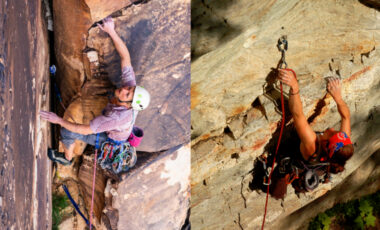Sit a bunch of climbers down in the same room and the sport vs trad climbing argument is almost guaranteed to rear its head. You’d be amazed at how divisive the subject can be, as, from the outside, it’s just about climbing up steep cliffs and getting to the top, right?
Well, sure. But there are also a load of differences between sport and trad climbing that, in many climbers’ eyes, make them very different sports. That said, for the most part, sport and trad climbing do not exist in opposition to one another. Many climbers interchange between the two (though some stick rigidly to their chosen type of climbing), as well as the third major rock climbing discipline of bouldering.
Any sport with a long history will invariably evolve, with minor tweaks to how it’s played. Some though undergo more radical change and split into different disciplines. Often that division is about simplifying the rules, making it less complicated, faster and more accessible. This happened when rugby league broke away from rugby union, and when T20 cricket split from one-day and Test-match formats.
The development of sport climbing from the older discipline of trad climbing is a similar story. But that is not to imply that newer is always better; the original way can be the best way!
This article will highlight the essential differences between sport and trad climbing. It will begin with definitions, then focus on key areas, such as the equipment you’ll need for each, as well as the different mental and physical skills. If you’re a beginner climber, you’ll also learn which one is likely to suit you best.
- What is trad climbing?
- What is sport climbing?
- Sport vs trad climbing: the similarities and differences
A small note about rock climbing terminology
If you’re totally new to world of rock climbing, you may find it useful to reference our Climbing Terms article as you read this one.
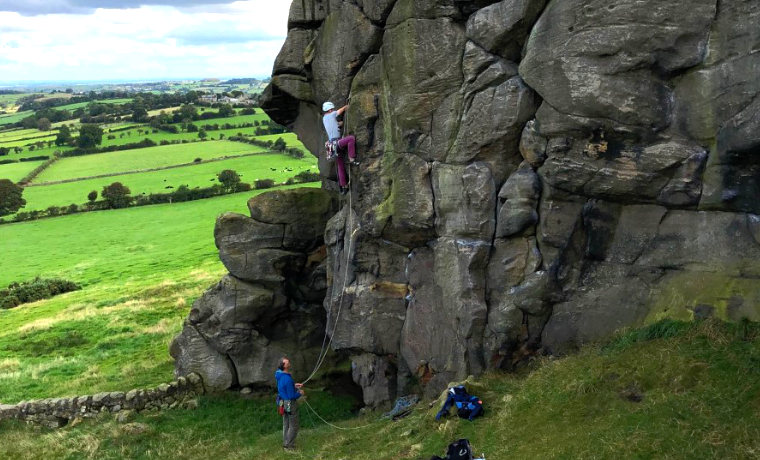
What is trad climbing?
Trad is short for traditional, which will help you remember that this is the earliest of the two climbing disciplines. It developed in the nineteenth century when bearded Victorians decided to brave their local crags. These were virgin pieces of rock with no man-made objects attached to them. The only way to get to the top ‘safely’ was to solo and not fall, or place protection (carried on the climber’s harness) into natural features of the rock. A rope was then fed through them, which anchored the climber and belayer to the rock.
This protection has developed considerably since the first pioneers, who used insecure methods like dropping pebbles into cracks and threading them with slings. Trad protection now includes some clever technology, particularly cams, to make it much safer: see below for further details.
However, in spite of the advancements in gear, the ethos of trad climbing remains the same: nothing should be permanently fixed to rock, and any protection added to the route in the course of climbing will be removed. Apart from chalk marking the holds – that can be brushed off or washed away by the rain – there should be no trace that the rock has been climbed.
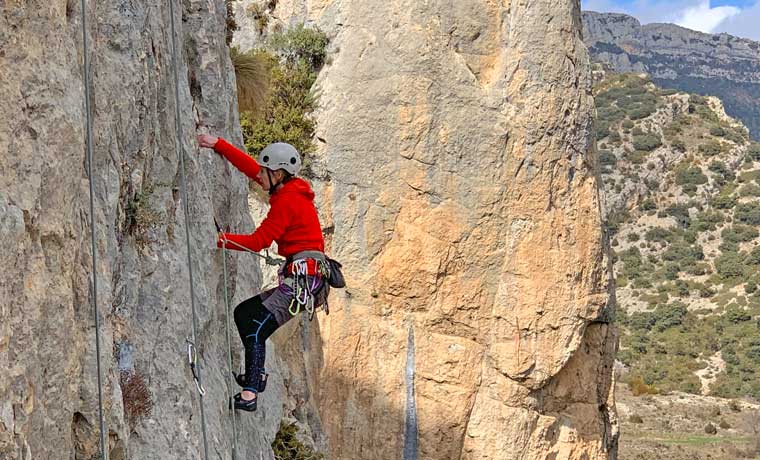
What is sport climbing?
Sport climbing developed in France in the 1980s. Its major difference from trad climbing is that protection is provided by pre-placed bolts, drilled into the rock at relatively safe intervals: around two to three metres apart. The lead sport climber then only needs to attach a quickdraw to the bolt, clip the rope, and continue on up!
In contrast to trad climbing, there is no need to carry a heavy rack of gear. The sport climber can therefore move quickly without the added weight and without the need to hang on one arm for too long whilst placing protection.
The sport climber can be extremely confident about the protection too; knowing that a bolt should not fail, she can focus on the climbing, pushing herself further and taking the safe fall in order to practise the moves.
The advent of sport climbing has also extended the range of rock that can be climbed. While trad climbing routes require features for gear – unless it’s very bold! – sport routes can pass through almost blank walls. This has the effect of increasing the difficulty of the climbing without increasing its danger.
Like bouldering (and unlike trad) sport climbing has the added advantage of being done indoors as well as outdoors, enabling the climber to exercise in all weather, with bolts close together that reduce the length of a fall … and easy access to coffee and pastries!
Sport vs trad climbing: the similarities and differences
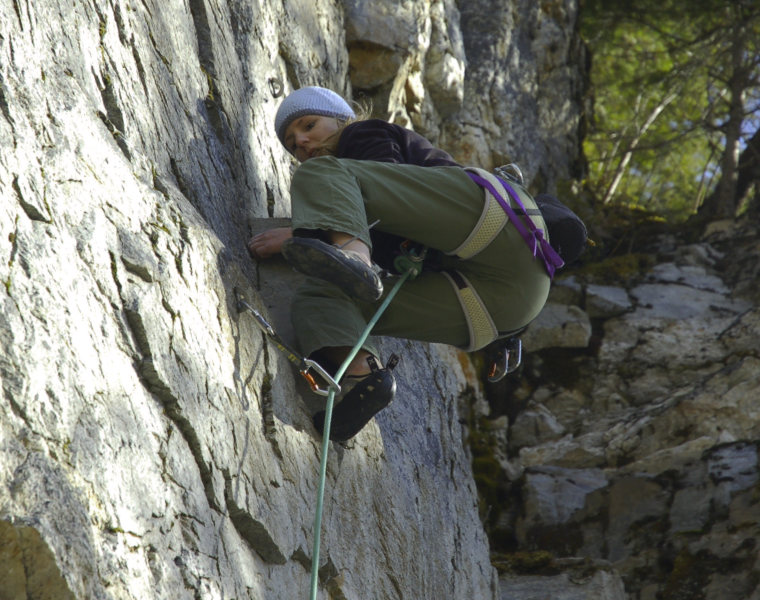
Sport vs trad climbing: style
The major difference in the style of sport and trad climbing stems from their history. Due to the limited or non-existence protection on original trad routes, it forced climbers into a ‘no fall’ approach. You would only commit to a route when you were supremely confident you could climb it. You could always down-climb if unsure, but that becomes harder the higher you go. Then if you did fall (and survive!) you could try again, but only from the ground-up. It would be against the early ethos of the sport to practise the moves on a top rope first.
Sport climbing though cares less about ethos! The end objective is still the same as trad: to climb the route free from bottom to top. But sport climbing is not as concerned as trad with onsighting: climbing the route on your first attempt with no prior information. Sport climbers are happier to practise on a top-rope, or rest on lead before eventually going for a clean lead. And it’s much safer to try many ground-up ascents and fall due to the security of the bolts. The style of sport climbing is therefore to treat falling as not failing, but part of the learning process to succeed.
However, the improvement of trad gear has partly blurred the boundaries between the two disciplines. When there’s a safe fall on bomber trad gear, it’s fine to try and try again. Also, it is more acceptable now, especially at the elite level, to top-rope trad route first before going for the lead.

Sport vs trad climbing: mental skills
Starting with similarities: for both sport and trad, climbers need the mental capacity to be able to climb at height, to cope with the fear that can cause. It also helps to become comfortable falling on protection below your feet, whether a bolt or trad gear, and trusting that you’ll be caught by your belayer. But that being said, for both disciplines, if you’re wary of falling, you can choose to climb easier routes very much within your limits, and approach climbing more like scrambling.
As for the key difference in mental skills,trad routes often have spaced gear placements or simply poor placements, which means it is not safe to fall. This occurs on low grade as well as hard routes, where the climbing is more closely related to free soloing. It is important to stay calm, to know and trust your physical ability. Bold trad routes can always be avoided, of course, but even when climbing a safe crack route, for example, you need the mental clarity to place the gear when under physical stress and trust that you’ve placed it correctly.
Sport climbing, on the contrary, is less mentally taxing because there is no real danger of the protection ripping away from the rock. And once you get to the second or third clip, you shouldn’t hit the ground … as long as your belayer is paying attention! Ground falls before then can also be mitigated by using a clip-stick to attach the rope to the lowest bolts.
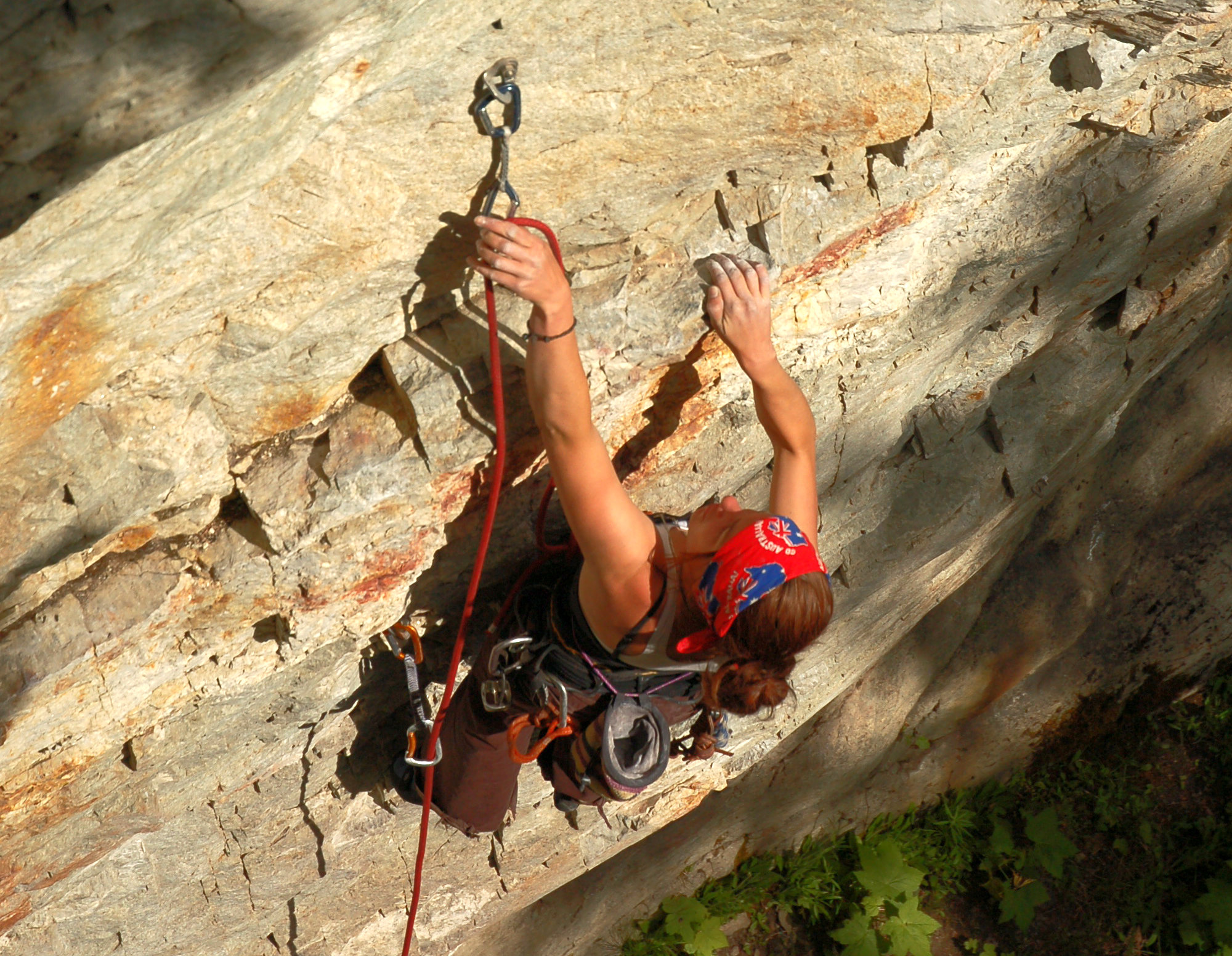
Sport vs trad climbing: physical skills / body types
From the perspective of the outsider, it might seem that all climbers have fingers of steel and zero % body fat! While this might describe elite climbers, it is perfectly possible to climb when not in perfect shape. This is especially true when you improve your technique.
Easy trad particularly lends itself to the less fit climber as there is often ample opportunity to rest on your feet without tiring your arms. And you’re still able to gain height and enjoy the experience of placing gear, as long as you have the necessary mental skills to manage the run-outs. However, for sport climbing, the lowest grades at most outdoor crags and indoor climbing centres require relatively more physical strength to climb in comparison to the lowest trad grades.
As you go further up the climbing grades though, the different physical attributes between sport and trad climbers becomes less marked. For example, if you climb in the f7’s on sport routes or in the mid E grades for trad, you will be strong regardless.
Trad climbing vs sport climbing: gear

Both forms of climbing need the same basic equipment: climbing shoes, chalk bag, harness, belay device, quickdraws and ropes. But whereas no more gear is required for sport climbing, trad climbers have the opportunity to purchase numerous shiny pieces of protection … so if you’re the type of person who picks a sport based on all the new kit and gear you’ll need, then trad is certainly for you!
 Trad protection can be divided into passive and active. The most common type of passive gear is the ‘nut’ – also called a ‘wire’ or ‘RP’ – which is placed into a constricting crack. Climbers carry a range of different sizes and shapes to find the best fit for the particular constrictions on the route, and when fitted correctly, they provide excellent protection.
Trad protection can be divided into passive and active. The most common type of passive gear is the ‘nut’ – also called a ‘wire’ or ‘RP’ – which is placed into a constricting crack. Climbers carry a range of different sizes and shapes to find the best fit for the particular constrictions on the route, and when fitted correctly, they provide excellent protection.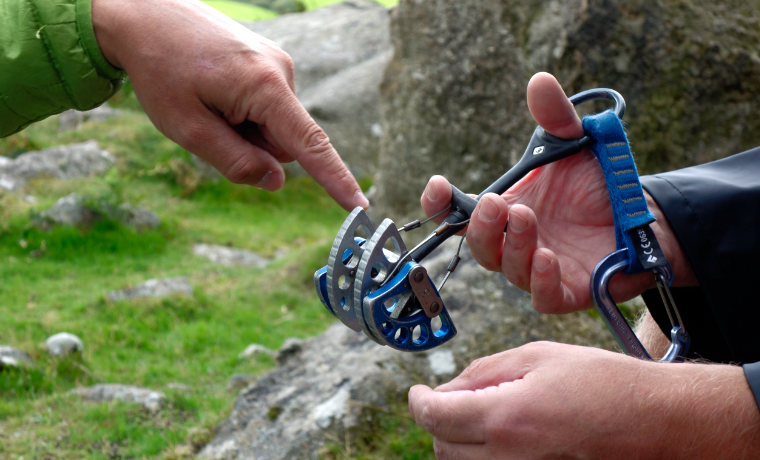 Active gear means it has moving parts, and ‘cams’ are the king! Developed in the 1970s, they come with a trigger that causes metal lobes to retract and therefore narrow. Once placed in the crack, the trigger is released and lobes push against the inside of the crack and remain securely in place in the event of a fall. They are a wonderful invention that has revolutionised trad climbing, enabling gear to be placed where once it was impossible.
Active gear means it has moving parts, and ‘cams’ are the king! Developed in the 1970s, they come with a trigger that causes metal lobes to retract and therefore narrow. Once placed in the crack, the trigger is released and lobes push against the inside of the crack and remain securely in place in the event of a fall. They are a wonderful invention that has revolutionised trad climbing, enabling gear to be placed where once it was impossible.
Learning to place protection is one of the major skills of trad climbing. While you can learn through trial and error, it is advisable to have an experienced climber show you what to do; or you can book yourself onto a course to learn the specialist skills needed to take on trad routes.
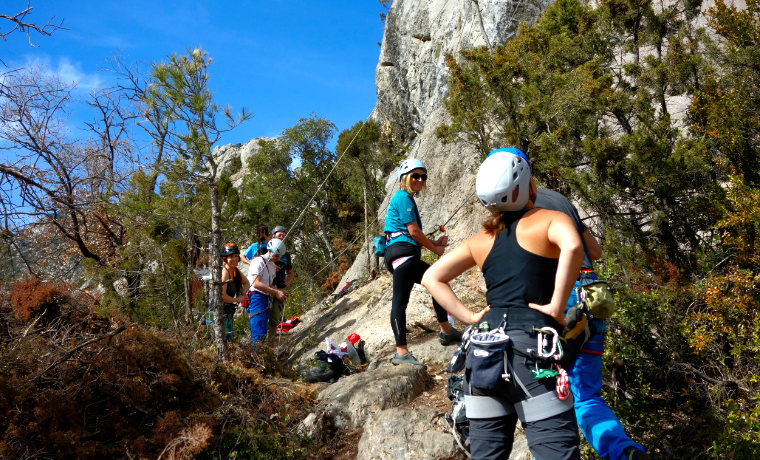
Sport vs trad climbing: accessibility and suitability for beginners
Sport climbing is generally more accessible and more suitable for beginners than trad. This is primarily due to the amount of gear needed for trad, which is expensive to buy and takes time to learn how to use safely. How to clip a quickdraw for sport climbing, on the contrary, is a quick skill to master.
And because trad climbing has more potential dangers than sport climbing, a beginner without the support of an experienced climber could end up unknowingly taking a high risk. This is not to say that sport climbing is perfectly safe – threading the anchor, for example, is risky if not done properly – but that the skills are easier to learn for a beginner.
As for distance to travel and closest to the car, sport climbing indoors is obviously the winner! But once outdoors it is much of a muchness between sport and trad. There are easily accessible sport crags, particularly quarries, but also multi-pitch mountain sport routes which require a long walk-in. Similarly, there are trad-climbing crags very close to the road – Burbage in the Peak District, for example – but others that require many hours to reach.
As stated above, one area where trad is more accessible is for the less fit climber. A major part of the discipline is experience in placing gear and mental conditioning – irrespective of how many one-arm pull-ups you can do! – and there are many wonderful low-grade trad routes around the country to keep you entertained well into your senior years.
Sport vs trad climbing: final thoughts
As stated at the beginning of this article, sport and trad do not exist in opposition. Climbers might favour one, but many do both. Not only are they excellent and highly rewarding disciplines in their own right, but they complement one another. Trad climbing will give the sport climber greater confidence when running out the rope between bolts, reducing the anxiety of desperately having to clip the next quickdraw; and sport climbing will give the trad climber greater strength and endurance.
So give them both a go!


